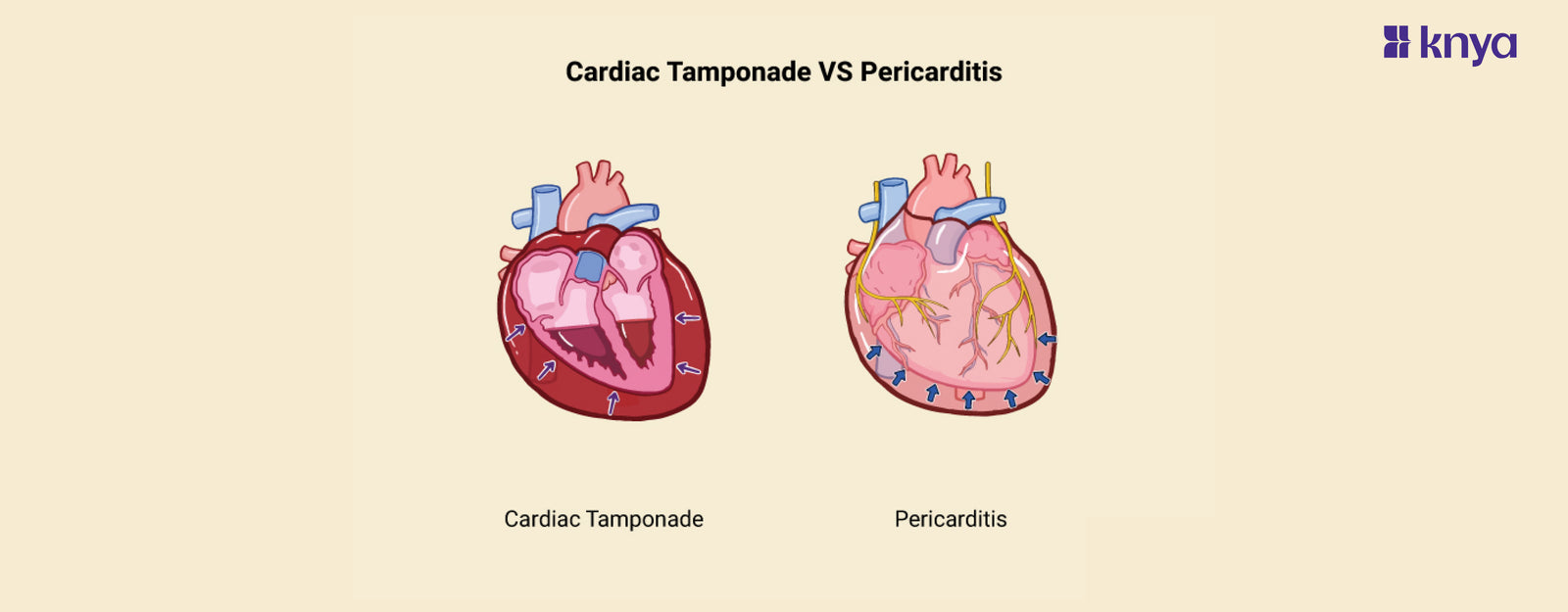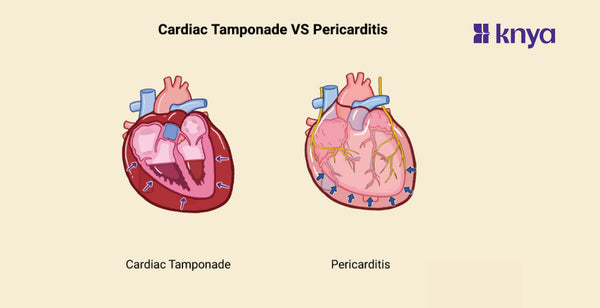Differences between Cardiac Tamponade and Pericarditis: Cardiac Tamponade and Pericarditis are two separate diseases that affect the pericardium. When fluid builds up in the pericardial sac, it compresses the heart and prevents it from working correctly, causing cardiac tamponade, which frequently manifests as symptoms like low blood pressure and shortness of breath. It needs to be treated medically right away, usually with fluid drainage. On the other hand, pericarditis, or inflammation of the pericardium, frequently results in symptoms such as chest pain. Usually, it is treated with drugs that lessen inflammation. Though they both affect the pericardium, there are notable differences in their etiologies, signs, and therapies.
Differences Between Cardiac Tamponade and Pericarditis
Cardiac Tamponade occurs when fluid accumulates in the pericardial sac, compressing the heart and necessitating immediate intervention. Inflammation of the pericardium caused by Pericarditis is treated with medicine and by addressing underlying causes. The table below gives the differences between Cardiac Tamponade and Pericarditis.
|
Aspect |
Cardiac Tamponade |
Pericarditis |
|
Definition |
Compression of the heart due to fluid accumulation in the pericardial sac |
Inflammation of the pericardium |
|
Causes |
Trauma, rupture of a blood vessel, cancer, pericardial effusion |
Viral infections (e.g., Coxsackie virus, Epstein-Barr virus), bacterial infections (e.g., tuberculosis), autoimmune diseases (e.g., rheumatoid arthritis), cancer, radiation therapy, medication side effects |
|
Symptoms |
Shortness of breath, chest pain, rapid heartbeat, low blood pressure, fainting |
Chest pain (sharp and stabbing), worsened by deep breaths or lying flat, fever, cough, weakness |
|
Diagnosis |
Physical examination (Beck's triad: low blood pressure, distended neck veins, muffled heart sounds), echocardiography, imaging studies (CT/MRI) |
Medical history, physical examination (pericardial friction rub), ECG/EKG (diffuse ST-segment elevation or PR depression), echocardiography (may show pericardial effusion), blood tests (elevated markers of inflammation) |
|
Treatment |
Pericardiocentesis (draining of fluid), surgery if necessary |
Medications (NSAIDs, colchicine, corticosteroids), treating underlying cause (antibiotics for bacterial infections, antivirals for viral infections) |
|
Urgency |
Medical emergency requiring immediate intervention |
Managed with appropriate medication, less urgent |
|
Complications |
Cardiogenic shock, cardiac arrest, organ failure if not promptly treated |
Recurrent pericarditis, constrictive pericarditis, effusive-constrictive pericarditis, cardiac tamponade (rare) |
|
Prognosis |
Good with prompt intervention; mortality rates increase if not treated quickly |
Generally good; recurrence can occur, but long-term outcomes are favorable with appropriate management |
|
Risk Factors |
Trauma, cardiovascular procedures, underlying medical conditions (cancer, autoimmune diseases) |
Recent viral infection, autoimmune diseases, history of pericarditis, chest trauma, radiation therapy, recent heart surgery |
Browse The Best Scrubs Collection!
What is Cardiac Tamponade?
When fluid accumulates around the heart, squeezing it and leading to serious issues like low blood pressure and heart failure, this condition is known as Cardiac Tamponade. For life-threatening complications to be avoided and pressure to be released, immediate medical intervention is essential.
Causes of Cardiac Tamponade
- Trauma: Bleeding into the pericardial sac from blunt or penetrating injuries to the chest can squeeze the heart.
- Pericardial Effusion: Tamponade can result from fluid accumulation in the pericardial sac as a result of illnesses such as infections, inflammation, malignancy, or heart surgery.
- Blood Vessel Rupture: Blood can quickly build up around the heart in the event of an aortic aneurysm or other severe blood vessel rupture, which can result in tamponade.
- Medical Procedures: Pericardial effusion and tamponade are possible side effects of invasive cardiac procedures, such as cardiac catheterization or pacemaker implantation.
- Idiopathic: Although the reason for cardiac tamponade may not always be identified (idiopathic), it is still a medical emergency that needs to be treated right away.
Symptoms of Cardiac Tamponade
- Breathlessness: As a result of compromised heart health and reduced cardiac output.
- Chest Pain: Usually described as acute, it can get worse when you lie down or breathe deeply.
- Tympanic Rhythm: The heart beats quickly to make up for a drop in cardiac output.
- Hypotension: Low blood pressure brought on by inadequate heart chamber filling as a result of compression.
- Dizziness or Fainting: Caused by insufficient blood supply to the brain.
- Fatigue or Weakness: As a result of tissues receiving less oxygen.
What is Pericarditis?
Pericarditis is inflammation of the pericardium, the membrane that surrounds the heart, which causes acute chest pain that is exacerbated by deep breaths or lying down. Numerous conditions, including infections, autoimmune illnesses, and heart attacks, can cause it. Medications are usually used as part of treatment to control symptoms and lower inflammation.
Causes of Pericarditis
- Infections Caused by Common Viruses: Pericarditis can be brought on by viruses that cause the flu or the common cold.
- Bacterial Infections: Pneumonia and TB are two examples of bacterial illnesses that can lead to pericarditis.
- Autoimmune Diseases: Rheumatoid arthritis and lupus are two ailments that can cause pericardial inflammation.
- Heart Attacks: Pericardial inflammation may arise from damage to the heart muscle during a heart attack.
- Cancer: Pericarditis can develop as a side effect of cancer therapy or as a direct result of the pericardium being involved in the malignancy.
- Radiation Therapy: When used to treat malignancies, radiation therapy aimed at the chest region may result in pericardial inflammation.
Symptoms of Pericarditis
- Chest Pain: Usually felt in the center or left side of the chest, it is frequently described as stabbing and acute. Sitting upright or bending forward may help ease the pain, although deep breathing, coughing, or resting flat may make it worse.
- Low-Grade Fever: A slight fever is possible for certain people.
- Breathing Difficulties: Having trouble breathing can happen, especially if you're lying flat.
- Fatigue: One may experience weakness or weariness in addition to pericarditis.
- Dry Cough: Although usually moderate, a persistent cough may be present.
- Palpitations: Feelings of an erratic or fast heartbeat are possible.
- Swelling: Although it is less frequent, some people may develop swelling in their legs or abdomen as a result of fluid buildup (pericardial effusion).
Shop Best Lab Coats From Here!
Similarities Between Cardiac Tamponade and Pericarditis
- Involvement of the Pericardium: The sac-like membrane that envelops the heart is impacted by both disorders.
- Chest Pain: Chest pain is a symptom that can be caused by cardiac tamponade or pericarditis. When pericarditis occurs, chest pain is usually acute and gets worse when you lie flat or breathe deeply. When cardiac tamponade occurs, chest pain can also occur, but it's usually accompanied by additional symptoms like low blood pressure and shortness of breath.
- Cardiovascular Symptoms: Shortness of breath, an accelerated heartbeat, and fainting are examples of symptoms associated with compromised heart function that can arise from either illness.
In conclusion, fluid buildup surrounding the heart is a key sign of Cardiac Tamponade, necessitating immediate medical attention such as pericardiocentesis. On the other hand, Pericarditis, which is treated with anti-inflammatory medications, causes inflammation of the pericardium. It's critical to understand these differences to provide prompt care and enhance patient outcomes.
Order the Best Jogger Scrub From Here!
| Check out More Articles | |
| Difference Between Tendon and Ligament | |
| Difference Between Seizure and Epilepsy | |
| Difference Between Hypothyroidism and Hyperthyroidism | |















